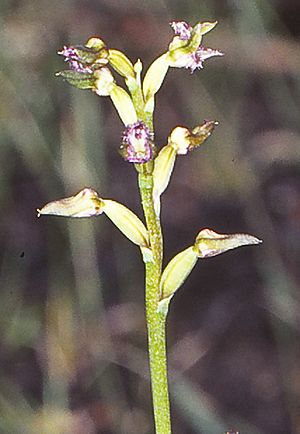Freak midge orchid facts for kids
The freak midge orchid (scientific name: Genoplesium apostasioides) is a small, special type of orchid that grows only in New South Wales, Australia. It has a single thin leaf that is joined to its flowering stem. This orchid produces up to fifteen small, yellowish-green flowers. These flowers have a reddish labellum (a special lip-like petal). What's interesting is that these flowers don't open very wide and they can even pollinate themselves! You can find this unique orchid growing in heath areas and in shallow moss gardens on rock ledges, from the Blue Mountains all the way to Nerriga.
Quick facts for kids Freak midge orchid |
|
|---|---|
 |
|
| Genoplesium apostasioides growing near Bomaderry | |
| Scientific classification | |
| Genus: |
Genoplesium
|
| Species: |
apostasioides
|
| Synonyms | |
Contents
What Does the Freak Midge Orchid Look Like?
The freak midge orchid is a terrestrial plant, meaning it grows in the ground. It's a perennial herb, which means it lives for more than two years and has soft stems. It also has an underground tuber, which is like a swollen root that stores food.
This orchid has one thin leaf that is about 150 to 300 mm (6 to 12 inches) long. This leaf is fused, or joined, to the flowering stem. The free part of the leaf, which isn't attached, is about 15 to 25 mm (0.6 to 1 inch) long.
Its Unique Flowers
The flowering stem grows to be about 20 to 40 mm (0.8 to 1.6 inches) tall. This stem is much taller than the leaf. It holds between three and fifteen yellowish-green flowers. These flowers are spaced out along the stem.
Each flower is about 4 to 5.5 mm (0.16 to 0.22 inches) long. They often don't open fully, or they open in an uneven way. These flowers are special because they can self-pollinate, meaning they don't need insects or wind to help them reproduce.
Like other orchids in its genus, the flowers of the freak midge orchid are inverted. This means the labellum (a special lip-like petal) is above the column (the part that holds the pollen) instead of below it.
Flower Parts
- The dorsal sepal is a leaf-like part at the back of the flower. It's shaped like a spear or an egg, about 5 mm (0.2 inches) long and 2.5 mm (0.1 inches) wide. It has hairy edges.
- The lateral sepals are on the sides. They are long and narrow, about 6.5 mm (0.26 inches) long and 2 mm (0.08 inches) wide. They usually grow parallel to each other and sometimes have a small gland (a tiny bump) on their tip.
- The petals are also shaped like a spear or an egg. They are about 4 mm (0.16 inches) long and 1.5 mm (0.06 inches) wide. They have hairy edges and a sharp, pointed tip.
- The labellum is reddish and about 7.5 mm (0.3 inches) long and 2 mm (0.08 inches) wide. It also has hairy edges and a sharp tip. There's a raised area called a callus in the middle of the labellum that almost reaches its tip.
This orchid usually flowers from December to April.
How the Freak Midge Orchid Got Its Name
The freak midge orchid was first officially described in 1888. A botanist named Robert D. FitzGerald gave it the scientific name Corunastylis apostasioides. He found a sample of the plant near Berrima and wrote about it in his book Australian Orchids.
Later, in 1989, two other botanists, David Jones and Mark Alwin Clements, changed its name to Genoplesium apostasioides. This is the scientific name it uses today.
Where Does the Freak Midge Orchid Live?
You can find Genoplesium apostasioides growing in forests and in mossy areas on rock shelves. It lives on the tablelands between the Blue Mountains and Nerriga in New South Wales.

